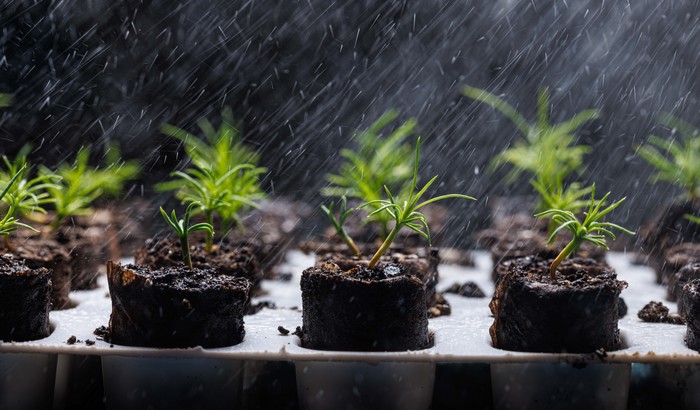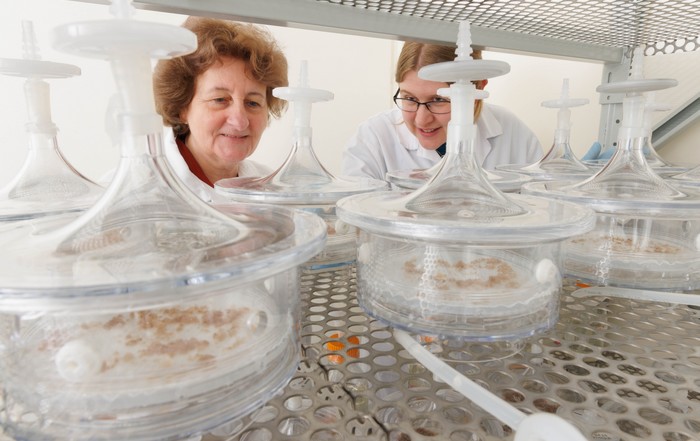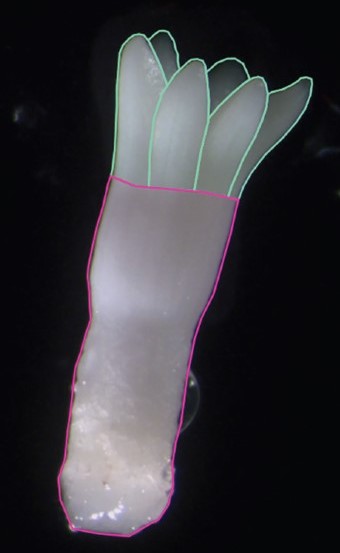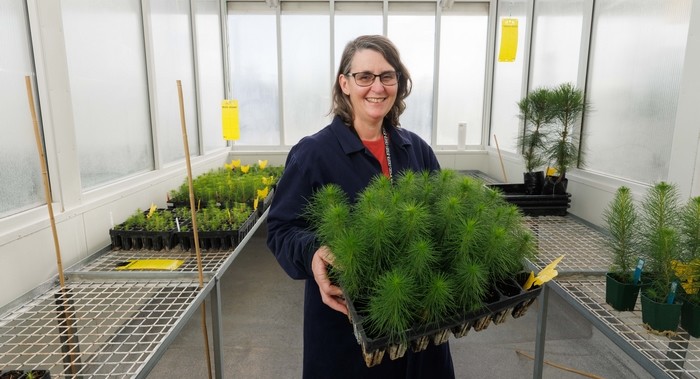Tissue culture for the 21st Century
Scion is rewriting the rulebook on tree propagation, ushering in a new era for forestry. It’s a world where trees are beginning their lives in a lab and where scientists are harnessing the power of AI and machine learning to boost productivity. Buckle up because the future of forestry has arrived.
The current approach to propagating forestry trees as varietals to deliver the very best trees into our forests is a labour-intensive exercise. Scion is partnering with Forest Growers Research (FGR) and industry on the Tissue Culture Techniques for the 21st Century Forests project which uses somatic embryogenesis as a reliable propagation method to ensure consistent results.

Scion has a long history of growing plants from seed, and propagation techniques that create new plants from cuttings, grafting and layering. This project is exploring the potential of how we can create new trees by growing plant cells in culture in a petri dish – a process that doesn’t require seeds to germinate. Scientists working in Scion’s tissue culture labs are using a technique called somatic embryogenesis that is playing a critical new role in clonal propagation for woody plants. The research is advancing knowledge to help improve ways the forestry industry can rapidly grow new trees from proven and high-performing genotypes.
Scion’s science lead on the project, Dr Jana Krajňáková, explains there is an urgent need for cost-effective, efficient tree vegetative propagation (bio)technologies for supporting the development of precision forestry, and delivery of forest products and services.
The FGR-led programme is funded by the Forest Growers Levy Trust (FGLT), MBIE, and Strategic Science Investment Fund, and aims to produce a reliable and cost-effective tissue culture process by using bioreactors and other high productivity systems to quickly produce small, rooted plantlets. The work will make dramatic improvements in the delivery of genetic gain and future biotechnology developments into tree stock.
Tissue culture and somatic embryogenesis
Somatic embryogenesis is a process that takes immature embryos, formed after pollination, from green cones. These embryos are then induced to produce masses of cells which contain many tiny somatic embryos. The embryogenic mass that originated from one immature zygotic embryo is called a cell line. These cell lines can be encouraged to form mature embryos that develop into seedlings which are acclimatised to nursery conditions and finally planted in the forest. This process is an extremely attractive option for the rapid reproduction of genotypes with proven performance.
Each tree species and cell line (genotype) within a single species requires its own set of instructions to get to the end goal – a robust plant.
Krajňáková stresses the complexity of figuring out the best conditions for a multitude of different cell lines.
“Tissue culture can be considered advanced cooking – it is more art than science.”
The current approach for somatic embryogenesis starts with a cell line and uses a semi-solid media for supplying the required nutrients. A potentially more efficient approach with liquid media in bioreactors is also being explored.
Temporary immersion bioreactors
Scion is the first institute to be investigating temporary immersion bioreactors for Pinus radiata. Using these bioreactors is a step towards automation and scale-up; instead of manually transferring somatic embryos between petri plates, the embryos grow in a liquid media in the bioreactors. Temporary immersion bioreactors of coniferous somatic embryos are not well studied. Scion has tried Pinus radiata, redwoods, and Douglas fir in the bioreactors; redwoods are the most promising at this stage.
Sharing the results with partners so far, our approach has created more openness. - Cathie Reeves
A new germination protocol
Scion tissue culture scientist Cathie Reeves has successfully developed a simplified propagation protocol that condenses the germination phase from five weeks to 10-14 days. The results showed greater survival rates and quality of the plants, which validates the shortened protocol – leading to reduced costs.
Reeves says “better quality plants mean better overall survival because the costs due to loss of plants is reduced”.
“We are also looking at ways of further reducing the timing and even removing an entire step involved in the process, which would further reduce costs.”
Krajňáková says one of the key outcomes is the relationship and development of trust between Scion and our industry partners in working with cell lines.
“Sharing the results with partners so far, our approach has created more openness,” she says.
FGR Tissue Culture Techniques for the 21st Century Forests programme manager Russell Burton says the project is building the industry’s body of knowledge. “The more sharing we have, the more we all learn and the more New Zealand increasingly gains from the programme.”
In the current Pinus radiata somatic embryogenesis process, the resilience of tissue-cultured plants, when transferred to the nursery, is poor. Root systems are often a limiting factor for their clonal deployment potential due to scarcity of roots, cessation of their growth and unbalanced architecture.

Machine learning
Machine learning wasn’t part of the original programme but after the first year it was highlighted as an opportunity to improve productivity. A small pilot project indicated the promising potential for increased productivity and greater automation. Since that time, additional resources have been injected into the programme in response to industry interest, and machine learning is now an integral part of the project.
The machine learning research is a bit like weather forecasting – it is based on repeated, high-quality inputs to predict which embryos are likely to thrive. The team is embracing modern technologies and increasingly using automation, which allows for more accurate measurement of somatic embryos, helping the selection process and making it more efficient.
The potential impact of this machine learning and artificial intelligence has been recognised by the forestry industry. FGR awarded Scion data scientist Sam Davidson the Young Researcher award for his machine learning work on this project at the FGR annual conference in September 2023.
FGR chief executive Paul Adams says Davidson is showing real passion for how the area of machine learning and artificial intelligence could create opportunities in forestry.
“In the four years since graduating, he is making a significant contribution to science and programmes of value to the New Zealand forestry industry.”
The scientific excellence of Scion’s tissue culture team was also acknowledged with the Science of International Quality award from FGR. This was based on the team’s ability to build key collaborations with world-leading international teams, and the number of scientific publications and speaking opportunities the team has produced in under four years.

Tissue culture can be considered advanced cooking – it is more art than science. - Dr Jana Krajňáková
International Union of Forest Research Organisations (IUFRO)
Krajňáková is an integral part of the upcoming International Union of Forest Research Organisations (IUFRO) conference, hosted by Scion in Rotorua. This event will bring together researchers, university professors, and PhD students from around the world to collaborate, exchange knowledge, and address specific research topics in forestry, and more generally woody plants.
The upcoming sixth international conference of IUFRO 2.09.02 unit, titled The might of vegetative propagation for healthy and productive forests to face climate challenges, will take place over five days, in March 2024. Previous conferences have been successfully held since 2010 in several countries, including the Republic of Korea, Czech Republic, Spain, Argentina, and Portugal.
“IUFRO serves as a platform for scientists and experts from around the world to collaborate on various aspects of forest research by facilitating communication and promoting the exchange of knowledge and expertise.
“A level of prestige comes with being the host organisation. It demonstrates our leadership, expertise, and commitment to evolving knowledge in vegetative propagation technologies, while providing the opportunity to highlight our recent advancements in this area.”
Additionally, Rotorua is scheduled to host the second international conference of IUFRO unit 1.01.04, focused on reinvigorating planted forest establishment research, in early 2025.

Tissue Culture Techniques for the 21st Century Forests is a partnership led by FGR and supported by Scion’s science expertise. It began in 2019 and funding is provided for at least seven years from FGLT, MBIE and SSIF. The programme has collaborated with Georgia Institute of Technology, USA, The Natural Resources Institute of Finland, and Otago University.
